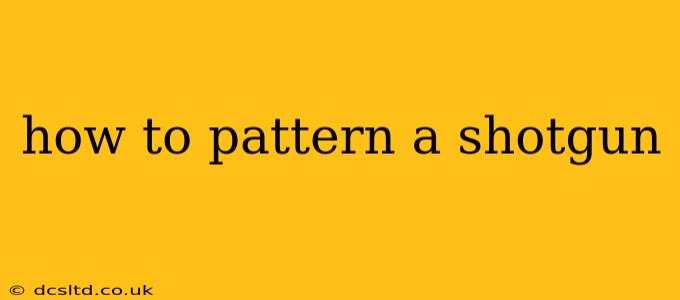How to Pattern a Shotgun: A Comprehensive Guide for Accuracy and Success
Pattern testing, or patterning, your shotgun is a crucial step for any serious shooter, whether you're hunting waterfowl, clays, or engaging in other forms of shotgun sports. It allows you to fine-tune your load and choke combinations to achieve optimal shot dispersion for your specific needs and shooting style. Ignoring this process can significantly impact your accuracy and effectiveness in the field or on the range. This guide will walk you through the entire process, answering common questions along the way.
What is patterning a shotgun?
Patterning a shotgun involves firing several shots at a target from a known distance, then analyzing the shot distribution to determine the effectiveness of your chosen ammunition and choke. The goal is to find the best combination that produces a consistent, dense pattern within a desirable spread. This helps you understand how your shotgun performs with different loads, ensuring you make accurate and ethical shots.
What equipment do I need to pattern my shotgun?
You'll need several key items:
- Your shotgun: Obviously, you'll need the shotgun you intend to pattern.
- Ammunition: Use the same type and brand of shells you plan to use in the field or on the range. Test several different loads if you're unsure which to use.
- Target: A large sheet of paper (at least 3 feet x 3 feet) will work well. You can also purchase specialized patterning targets with circles to aid in analysis.
- Measuring tape: To accurately measure the distance to the target.
- Shooting rest (optional but recommended): A rest helps maintain consistency and minimizes shooter error.
- Safety glasses and ear protection: Always prioritize safety!
What is the best distance to pattern a shotgun?
The ideal patterning distance depends largely on your intended use. For hunting, common distances are 25-40 yards. Clay shooting may require different distances depending on the target. It’s best to pattern at the distances you'll typically engage your targets. It is generally recommended to begin patterning at 25 yards to establish a baseline, and then test at further distances as needed.
How many shots should I fire when patterning?
For reliable results, fire at least five shots at your target for each ammunition and choke combination you test. More shots will provide a more statistically accurate representation of your shotgun's pattern.
How do I interpret the pattern?
After firing your shots, carefully examine the pattern on your target. Look for:
- Shot density: The concentration of shot within a specific area. A dense pattern indicates better accuracy and killing power.
- Pattern size: The overall spread of the shot. This should be appropriate for your target. Too narrow, and you may miss; too wide, and you may waste shot.
- Uniformity: A consistent pattern indicates reliable performance. Uneven shot distribution suggests potential problems with your shotgun, choke, or ammunition.
What if my shotgun pattern is inconsistent or poor?
Inconsistent or poor patterns can be caused by several factors including:
- Choke issues: A damaged or improperly installed choke can significantly impact your pattern.
- Ammunition problems: Not all ammunition performs the same. Experiment with different loads.
- Shotgun malfunction: A mechanical issue with your shotgun could be the cause. Have it inspected by a qualified gunsmith.
Don't hesitate to consult with a professional gunsmith or experienced shooter if you're struggling to achieve a satisfactory pattern. They can offer valuable insights and help troubleshoot any problems you may encounter.
How do I choose the right choke for my shotgun?
The correct choke depends on the game you're hunting and the distance to the target. Generally:
- Improved Cylinder: Offers a wider pattern, suitable for close-range shots.
- Modified: A good all-around choke providing a balance between pattern density and spread.
- Full: Produces a tight pattern ideal for longer-range shots.
- Extra Full: The tightest choke, offering maximum range but a very narrow pattern.
Remember to always consult your shotgun's manual for specific choke recommendations.
By following these steps and carefully analyzing your results, you can effectively pattern your shotgun and significantly improve your shooting accuracy and success. Remember safety is paramount – always follow safe gun handling practices.
